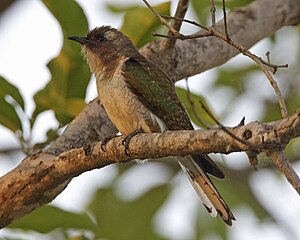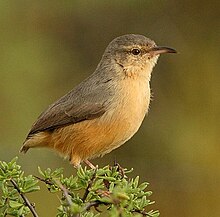Klaaskuckuck
| Klaaskuckuck | ||||||||||
|---|---|---|---|---|---|---|---|---|---|---|

Female Klaaskuckuck ( Chrysococcyx klaas ) |
||||||||||
| Systematics | ||||||||||
|
||||||||||
| Scientific name | ||||||||||
| Chrysococcyx klaas | ||||||||||
| ( Stephens , 1815) |
The Klaas Cuckoo ( Chrysococcyx klaas ), and Klaas-Cuckoo is one African occurs cuckoo, which preferably in loosely wooded regions. Like all cuckoos in the genus of the real gold cuckoos , it is an obligatory brood parasite that lays its eggs in the nests of host bird species.
Due to the large distribution area and the frequency of the species, although no population size estimates are available, it is not considered endangered.
features
The Klaaskuckuck is one of the smaller cuckoos. It reaches a body length of up to 18 centimeters. The beak accounts for around 1.6 centimeters, the tail feather between 7 and 8 centimeters. Males weigh an average of 25.6 grams, the females are slightly heavier with an average of 30.2 grams.
The gender dimorphism is different in this type of cuckoo. As with other representatives of the genus Chrysococcyx , the plumage of the males is strikingly green and glossy on top. The chest and stomach plumage, however, is white. The males often have a white spot behind the eye, but the region from the base of the beak to the eye is green. The iris is dark brown. The beak is olive to pale green.
The coloring of the female varies depending on the distribution area. The females in the south of the distribution area differ significantly from the males. The top of the body was banded in a shiny brown-green color. The underside of the body is cream-colored, and behind the eye they have a cream-colored spot. The region between the base of the beak and the eye is brown, as are the ear covers . The chin patch is whitish and merges into a cream-colored throat and front breast. The sides of the chest are brown or brown sparred in different sizes. Females in the northern part of the range show more similarity to the males. Their plumage on the upper side of the body is more strongly covered with metallic-green, the underside of the body is less clogged. Regardless of the distribution area, the iris in the female is light gray, the beak is darker than in the male and often has a dark tip. Young birds initially resemble females and have hazel eyes.
The males of the Klaaskuckuck can be confused with the golden cuckoo , as both species have a green, feathery top and a white bottom. The gold cuckoo, however, has a noticeable white stripe above the eyes and generally more white parts on the head. The sides of the body of the gold cuckoo are also, unlike the klaas cuckoo, noticeably dark green. The noticeable white over-eye stripe is also found in the female.
The typical call of the Klaaskuckuck is a whistling, two-syllable dee-da , which is recited four times in 3 to four seconds. Occasionally a monosyllabic dew can also be heard.
distribution and habitat
The Klaaskuckuck can be found all year round in Central Africa , Mozambique , from the west coast of Africa in Guinea to Ethiopia , as well as in the Cape region of South Africa . During the rainy season, it also breeds in Namibia , in eastern South Africa and along the Sahel from Senegal to Eritrea , and rarely on the west coast of Saudi Arabia .
Great cuckoos live in evergreen forests, gallery forests and dry forests . They are more common in open savannah landscapes than their close relative, the emerald cuckoo , but they prefer more densely wooded and humid habitats than the golden cuckoo. They can be found sporadically at altitudes of 3000 meters, but in Eritrea they are rare above 1220 meters and the same applies to Rwanda above 2000 meters. They are able to adapt to living spaces that have been reshaped by humans and can also be found in gardens and parks in urban areas. This habitat is also attractive for them because nectar birds, which are essential host birds for them, find many breeding opportunities here.
The Klaas cuckoo is rarer than the golden cuckoo, especially in West Africa , but the Klaas cuckoo is more common in the Republic of South Africa .
Way of life
food
The diet consists largely of insects , mostly caterpillars , which are pecked from bushes and trees. However, other insects are also caught in flight from a hide. Occasionally the cuckoo also eats fruit. As with many cuckoos, very hairy caterpillars are also part of the food spectrum of the Klaaskuckuck, which other bird species usually avoid. Similar to the golden cuckoo, they also eat butterflies, which are not eaten by other birds because of their unpleasant taste. Beetle larvae are also part of the food spectrum.
Reproduction
Great cuckoos are breeding parasites , their host parents are u. a. Nectar birds and warblers that are common in the habitat of the Klaaskuckuck. In various studies a degree of parasitization of 2.6 percent of the nests of the long-billed sylvetta , 8 percent of the soot nectar bird and 7 percent of the piritbatis has been established. Klaas cuckoos also parasitize weaver birds , but the degree of parasitization by klaas cuckoos in this family of birds is significantly lower than that of the golden cuckoo due to the different habitat requirements. The females of the cuckoo can lay up to 24 eggs in a breeding season. They usually lay three to four eggs one day apart before taking a break. As a rule, they lay their egg in the host bird's nest after it has started its clutch. There is no egg imicry as found in many brood parasitic cuckoos. The eggs are basically very variable in color: They are white to pale blue and are either without any markings or occasionally dense reddish-brown or purple-gray speckled.
When laying eggs, the female usually removes an egg from the host bird's clutch. This removed egg is also occasionally eaten by the females. As with other species of the genus Chrysococcyx , young birds are sometimes additionally fed by male Klaasuckucks. Reasons for brood care are not known. NB Davies thinks it is possible that this behavior is a misguided courtship behavior of the Klaasmännchen. Courting males of the Klaas cuckoo offer the courted female caterpillars as food.
The nestlings of the Klaas cuckoo hatch after 11 to 12 days, a significantly shorter period than the host bird species. The nestlings begin to throw other nestlings and eggs of the host bird out of the nest from their fourth day of life. The nestling is still blind at this point, its eyes only open from the sixth day. It spends between 19 and 21 days in the nest and is fed by the host bird parents outside the nest for another two to three weeks.
Trivia
The German name and the specific epithet honor the Khoikhoi servant Klaas of the French naturalist and zoologist François Levaillant , who found the bird in 1784.
literature
- Johannes Erritzoe, Clive F. Mann, Frederik Brammer, Richard A. Fuller: Cuckoos of the World (Helm Identification Guides). Christopher Helm Publishers Ltd, London 2012, ISBN 978-071-366-034-0 .
- Paul A. Johnsgard: The Avian Brood Parasites - Deception at the Nest. Oxford University Press, Oxford 1997, ISBN 0-19-511042-0 .
- Irby J. Lovette, Dustin R. Rubenstein and Wilson Nderitu Watetu: Provisioning of Fledgling Conspecifics by Males of the Brood-Parasitic Cuckoos Chrysococcyx klaas and C. caprius. In: The Wilson Journal of Ornithology. Volume 118, No. 1, 2006, pp. 99-101.
Web links
- BirdLife International: Species Factsheet - Klaas's Cuckoo ( Chrysococcyx klaas ) . Retrieved November 11, 2012.
- Videos, photos and sound recordings of Klaas's Cuckoo (Chrysococcyx klaas) in the Internet Bird Collection
- The Klaaskuckuck's calls to Xeno-Canto
Individual evidence
- ↑ a b Erhitzøe, Mann, Brammer, Fuller: Cuckoos of the World. P. 348.
- ↑ Chrysococcyx klaas in the endangered Red List species the IUCN 2012. Posted by: BirdLife International, 2012. Accessed August 24, 2012th
- ↑ Johnsgard: The Avian Brood Parasites. P. 246.
- ↑ a b c d e Erhitzøe, Mann, Brammer, Fuller: Cuckoos of the World . P. 349.
- ↑ Erhitzøe, Mann, Brammer, Fuller: Cuckoos of the World. P. 343.
- ↑ Johnsgard: The Avian Brood Parasites. P. 247.
- ↑ Calls of the Klaaskuckuck on Xeno-Canto , accessed on September 6, 2016.
- ↑ a b Erhitzøe, Mann, Brammer, Fuller: Cuckoos of the World. P. 351.
- ↑ Johnsgard: The Avian Brood Parasites. P. 248.
- ↑ Erhitzøe, Mann, Brammer, Fuller: Cuckoos of the World. P. 345.
- ↑ a b Erhitzøe, Mann, Brammer, Fuller: Cuckoos of the World . P. 350.
- ↑ Lovette et al. 2006
- ↑ NB Davies: Cuckoos, Cowbirds and Other Cheats. T & AD Poyser, London 2000, ISBN 0-85661-135-2 , p. 88.
- ↑ Bo Beolens, Michael Watkins: Whose Bird? Men and Women Commemorated in the Common Names of Birds . Christopher Helm, London 2003, ISBN 0-7136-6647-1 , pp. 205 .

